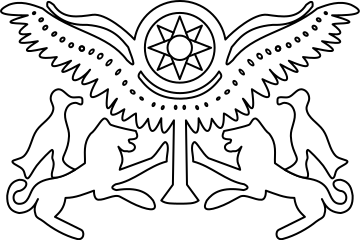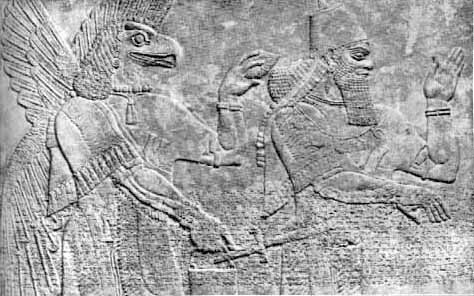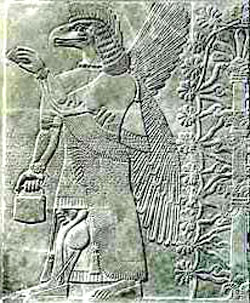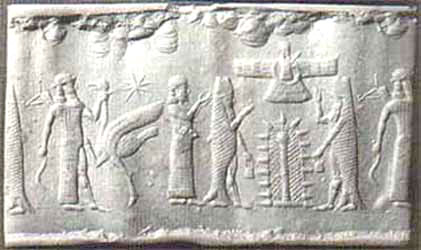Install the app
How to install the app on iOS
Follow along with the video below to see how to install our site as a web app on your home screen.

Note: This feature currently requires accessing the site using the built-in Safari browser.
You are using an out of date browser. It may not display this or other websites correctly.
You should upgrade or use an alternative browser.
You should upgrade or use an alternative browser.
Indo-European Language Originated On The Steppe?
- Thread starter Aberdeen
- Start date
Goga
Banned
- Messages
- 2,651
- Reaction score
- 152
- Points
- 0
- Y-DNA haplogroup
- R1a*
- mtDNA haplogroup
- HV1b2
" Indo-European before the Indo-Europeans? - new evidence from Mesopotamia
Fresh evidence from the Land of the Two Rivers suggests otherwise. For many decades now, leading Assyriologists have speculated on the existence of an early population in the 4th millennium B.C. that preceded the Sumerians, hitherto generally regarded as the first settlers of the region. Evidence for such a population comes from place names, the names of deities, technical vocabulary and even from environmental terms. Such speculation has proven fruitless, since no linguistic group or archaeologically attested society could be shown to be related. However, in a number of recent publications data have been presented that suggest that one such linguistic group is indeed comparable -- the Indo-European family of languages. Polysyllabic terms lacking a Sumerian etymology can be demonstrated to resemble segmentable Indo-European words with comparable meanings. Furthermore, the cuneiform writing system can be shown to preserve traces of Indo-European influence in its sign values and in its sign composition. "
http://rootsofeurope.ku.dk/english/calendar/archive_2009/euphratic/
Fresh evidence from the Land of the Two Rivers suggests otherwise. For many decades now, leading Assyriologists have speculated on the existence of an early population in the 4th millennium B.C. that preceded the Sumerians, hitherto generally regarded as the first settlers of the region. Evidence for such a population comes from place names, the names of deities, technical vocabulary and even from environmental terms. Such speculation has proven fruitless, since no linguistic group or archaeologically attested society could be shown to be related. However, in a number of recent publications data have been presented that suggest that one such linguistic group is indeed comparable -- the Indo-European family of languages. Polysyllabic terms lacking a Sumerian etymology can be demonstrated to resemble segmentable Indo-European words with comparable meanings. Furthermore, the cuneiform writing system can be shown to preserve traces of Indo-European influence in its sign values and in its sign composition. "
http://rootsofeurope.ku.dk/english/calendar/archive_2009/euphratic/
Goga
Banned
- Messages
- 2,651
- Reaction score
- 152
- Points
- 0
- Y-DNA haplogroup
- R1a*
- mtDNA haplogroup
- HV1b2
I'm sure that the Sumerians were the ancestors of the proto-Iranic people, like the Mitanni. I believe that the Medes & Persians evolved from those Mitanni Sumerian folks! There’re many links between the Sumerian mythology, ancient Iranic religions and my native current Iranic religion called the Yezidism.
Look at the BIRDS on two lions of the Mitanni ROYAL seal with the SUN between the wings!
Šauštatar's royal seal:

And look at the holy bird of my native Iranic religion, the Yezidism.

Birds were also ancient Mythological angels according to the Sumerians.
Also look at the Sumerian cuneiform for An, same as we the Ezdi Kurds have, left of that bird.

Also, Sumerians were the SUN worshippers, just like my people, the Iranic Ezdi Kurds, and our Iranic ancestors the Medes and Mitanni…
Look at the BIRDS on two lions of the Mitanni ROYAL seal with the SUN between the wings!
Šauštatar's royal seal:

And look at the holy bird of my native Iranic religion, the Yezidism.

Birds were also ancient Mythological angels according to the Sumerians.
Also look at the Sumerian cuneiform for An, same as we the Ezdi Kurds have, left of that bird.
Also, Sumerians were the SUN worshippers, just like my people, the Iranic Ezdi Kurds, and our Iranic ancestors the Medes and Mitanni…
Goga
Banned
- Messages
- 2,651
- Reaction score
- 152
- Points
- 0
- Y-DNA haplogroup
- R1a*
- mtDNA haplogroup
- HV1b2
Sumerian Bird God, the Annunaki



Aquatic - Enki - Sumer - Zoroaster above Tree of Life - Persia
http://www.bibliotecapleyades.net/imagenes_sumeranu/sumeranu14_09.jpg



Aquatic - Enki - Sumer - Zoroaster above Tree of Life - Persia
http://www.bibliotecapleyades.net/imagenes_sumeranu/sumeranu14_09.jpg
@holderlin,
Interesting, so Slavic B is as close to Slavic A as to Baltic. Do you know what is meant there by Slavic B and Slavic A?
I think Slavic A is West/South and B is East, but I'm not entirely sure. It's Isogloss 17.
Sumerian Bird God, the Annunaki



Aquatic - Enki - Sumer - Zoroaster above Tree of Life - Persia
http://www.bibliotecapleyades.net/imagenes_sumeranu/sumeranu14_09.jpg
Goga if PIE is actually proto-euphratic it would be the coolest thing ever. But it's not because it's an absurd theory. I'm trying to think of an analogy that would impart a more universal measure of this absurdity but such a tool is escaping me at the moment.
Where did you get this table from then?
Original wave model is from a 1972 (1989 2nd addition) book by Raimo Anttila http://books.google.com/books/about/Historical_and_Comparative_Linguistics.html?id=2C25_9m7U-AC
It's expounded up by Heggarty in this paper http://www.ncbi.nlm.nih.gov/pmc/articles/PMC2981917/
And I stumbled upon some supplementary information on the Heggarty paper here http://www.languagesandpeoples.com/Eng/SupplInfo/AnttilaNeighborNet.htm
Enjoy.
It's actually a relatively simple model compared to some of the crazier way people can try to quantify language change, which I think might be a waste of time given all of the chaotic variables.
Sile
Banned
- Messages
- 5,110
- Reaction score
- 582
- Points
- 0
- Location
- Australia
- Ethnic group
- North Alpine Italian
- Y-DNA haplogroup
- T1a2 -Z19945..Jura
- mtDNA haplogroup
- H95a1 ..Pannoni
Original wave model is from a 1972 (1989 2nd addition) book by Raimo Anttila http://books.google.com/books/about/Historical_and_Comparative_Linguistics.html?id=2C25_9m7U-AC
It's expounded up by Heggarty in this paper http://www.ncbi.nlm.nih.gov/pmc/articles/PMC2981917/
And I stumbled upon some supplementary information on the Heggarty paper here http://www.languagesandpeoples.com/Eng/SupplInfo/AnttilaNeighborNet.htm
Enjoy.
It's actually a relatively simple model compared to some of the crazier way people can try to quantify language change, which I think might be a waste of time given all of the chaotic variables.
some of the stuff is from this 2012 paper from univ. of california
https://escholarship.org/uc/item/9v44n49p#page-10
some of the stuff is from this 2012 paper from univ. of california
https://escholarship.org/uc/item/9v44n49p#page-10
Wow, that's some dude's dissertation. Jam packed with info.
MOESAN
Elite member
- Messages
- 5,888
- Reaction score
- 1,294
- Points
- 113
- Location
- Brittany
- Ethnic group
- more celtic
- Y-DNA haplogroup
- R1b - L21/S145*
- mtDNA haplogroup
- H3c
Nobody is disputing that the Indo-European pastoralists migrated into areas of Europe that had crop farming and borrowed some agricultural terms from the people who were already living there. But certain words with relevance to pastoralists are of IE origin (e.g., the English word horse is derived, through old Germanic language, from the IE word ekwo), so I'm not sure what point you're trying to make.
HORSE < > *EKWO ??? My head feathers are dropping down on my shoes! please check your sources... just concerning this very word
MOESAN
Elite member
- Messages
- 5,888
- Reaction score
- 1,294
- Points
- 113
- Location
- Brittany
- Ethnic group
- more celtic
- Y-DNA haplogroup
- R1b - L21/S145*
- mtDNA haplogroup
- H3c
Original wave model is from a 1972 (1989 2nd addition) book by Raimo Anttila http://books.google.com/books/about/Historical_and_Comparative_Linguistics.html?id=2C25_9m7U-AC
It's expounded up by Heggarty in this paper http://www.ncbi.nlm.nih.gov/pmc/articles/PMC2981917/
And I stumbled upon some supplementary information on the Heggarty paper here http://www.languagesandpeoples.com/Eng/SupplInfo/AnttilaNeighborNet.htm
Enjoy.
It's actually a relatively simple model compared to some of the crazier way people can try to quantify language change, which I think might be a waste of time given all of the chaotic variables.
I suppose there is no unique parfect representation, family tree and waves of propagation interfere - basically the tree system seems more reliable, the waves system requires uninterrupted contacts and inter-intelligibility at some level, which is linked too to time - loan words for material consumering is another story, we can see today, everyday - even tolks are not needed then -
I suppose there is no unique parfect representation, family tree and waves of propagation interfere - basically the tree system seems more reliable, the waves system requires uninterrupted contacts and inter-intelligibility at some level, which is linked too to time - loan words for material consumering is another story, we can see today, everyday - even tolks are not needed then -
Yes, as with every model you have to take all considerations when drawing broader conclusions. I like the wave because as you say it allows you to look at the languages themselves for a moment, which is very revealing. Trees for some reason, with me at least, seem to confer some sort of presupposition. I end up taking more from them than they are actually meant to give. I dunno.
Aberdeen
Regular Member
- Messages
- 1,835
- Reaction score
- 380
- Points
- 0
- Ethnic group
- Scottish, English and German
- Y-DNA haplogroup
- I1
- mtDNA haplogroup
- H4
HORSE < > *EKWO ??? My head feathers are dropping down on my shoes! please check your sources... just concerning this very word
I got that from an online Proto-Indo-European dictionary I can't seem to find at the moment, but the University of Texas site says the Indo-European word for horse is ekuos and I found the word ekwos at an Indo-European dictionary site. So it looks as if the experts differ slightly, or perhaps it's the difference between PIE and IE, but all three sources seem to agree that the IE name for equine creatures is ekwo, ekwos or something similar. And the Gaelic name for horse is eich, the Latin name for horse is equus and the Sanskrit is azva. I realize the French word for horse is different.
MOESAN
Elite member
- Messages
- 5,888
- Reaction score
- 1,294
- Points
- 113
- Location
- Brittany
- Ethnic group
- more celtic
- Y-DNA haplogroup
- R1b - L21/S145*
- mtDNA haplogroup
- H3c
I got that from an online Proto-Indo-European dictionary I can't seem to find at the moment, but the University of Texas site says the Indo-European word for horse is ekuos and I found the word ekwos at an Indo-European dictionary site. So it looks as if the experts differ slightly, or perhaps it's the difference between PIE and IE, but all three sources seem to agree that the IE name for equine creatures is ekwo, ekwos or something similar. And the Gaelic name for horse is eich, the Latin name for horse is equus and the Sanskrit is azva. I realize the French word for horse is different.
OK it's laughable of mine - I misunderstood and thought you were saying *ekwos was from the same I-E root as "horse" when you was saying, I guess, both have same meaning, what is not same etymology - apologize- good night
Melancon
Banned
- Messages
- 467
- Reaction score
- 35
- Points
- 0
- Location
- Lafayette, Louisiana
- Ethnic group
- Celto-Germanic (70% Cajun French - 30% English)
- Y-DNA haplogroup
- R1b (S21) - Nordic
- mtDNA haplogroup
- H (H1) - Atlantid
I read somewhere and I think I found out the same thing about PIE and Horse/Ekwo. Although, I think it probably had an accent. So it wasn't necessarily pronounced as Ekwo. (at least in an English/Latin/Greek way)HORSE < > *EKWO ??? My head feathers are dropping down on my shoes! please check your sources... just concerning this very word
This thread has been viewed 20829 times.
